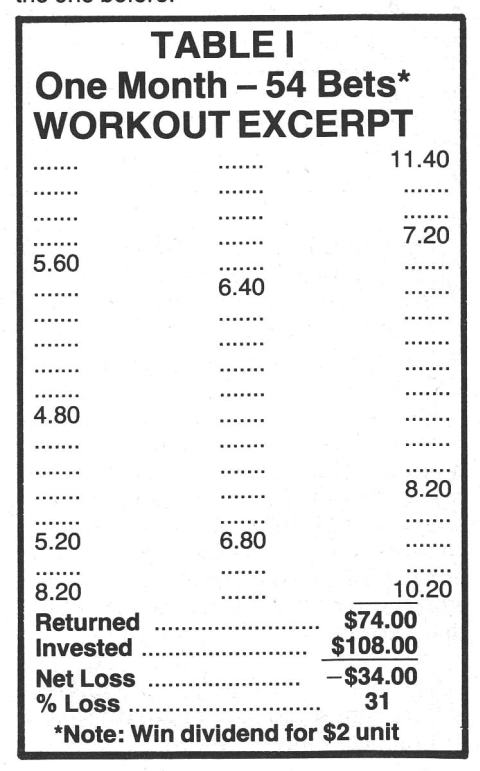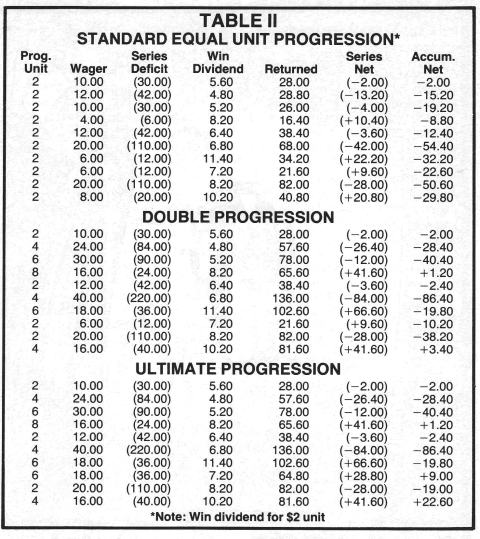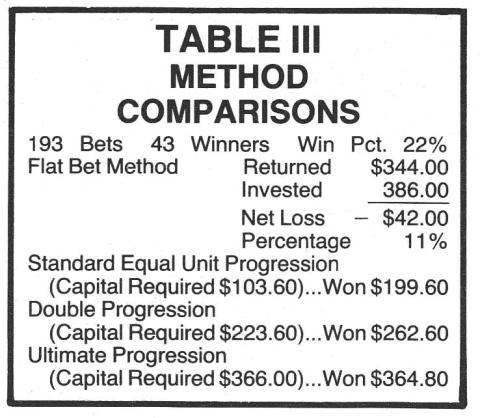Over the years, many people have come up with staking methods to beat the races and many of these involved progression betting.
Of the long-term betting methods that are around, most of the successful ones are sure to involve some sort of progression in the staking.
Progression, of course, is the technique of increasing your betting units following each loss. There are a host of ways to do this.
Simple facts and figures show that any form of progression betting will tend to swing the pendulum of percentages in the bettor's favour. But that isn't the end of the story by any means. Punters have to realise that progression alone is rarely the answer to the daily prayers of the turf speculator.
If we assume that the average punter uses a progression betting method with his selections, we can say with some authority that it would, at best, merely help to cut down losses. A very good method might achieve a break-even point, so bearing all this in mind, it takes what we can only describe as an excellent progression method - and usually one tailor-made to a punter's selection style - to achieve any worthwhile profits.
The initial advice that has to be offered in regard to progression play is this: Act with caution. The demands, and therefore the dangers, are far greater than those associated with simple flat-bet punting.
The inherent problem with progression play is that of excessive capital demands. With most techniques, you strike the danger of having to cope with huge demands on your resources in order to achieve the winning results you are chasing.
Have you, then, got the deep pockets required to cope with your progression method? It's a question you should ask yourself before you begin to play any method of progression betting.
Better be careful at the start than to be caught in midstream without a bank to continue.
A classic example is that of the heartstopping 'double-up' progression, where hardy punters double their bets after each loss (2, 4, 8, 16, 32, 64, 128 etc). It doesn't take you too long to realise what a mammoth betting bank you would need to cope with a longish losing run. If you struck twelve losers in a row - and this is very easily done - your thirteenth selection would require a bet of $4096, with the betting capital required to that point being $8090.
So, obviously, the 'double-up' method of play is for those magnificent people who strike winner after winner and never have to cope with losing runs (and, naturally, people who have oodles of cash as well).
Not all progression need be as hazardous and stroke-producing as the 'doubleup'. There are a few methods which can be used quite effectively without placing the punter at great risk.
The method we are about to outline is one of them, and we call it The Ultimate Progression. Before we get into the explanation of it, there are two points that need to be made absolutely clear.
Firstly, the ultimate goal of every serious punter should be to obtain flat bet profits on his selections. If you are relying solely on 'trick' betting to achieve a profit then you are in dangerous waters.
Secondly, we are not recommending The Ultimate Progression for use by beginners and casual amateurs. You really do have to comprehend the technique and you need the capital to back it up, as well as selection judgement that is better than that of the average punter.
If you hold doubts in this area then tread warily. By all means study the progression method closely and if you think you can handle it, all well and good.
The merit in The Ultimate Progression is that it can achieve near maximum results without the excessive capital demands that usually accompany such methods. Built into it, too, are safety factors that make full use of the law of averages and which protect the method from the worrying extremes of those averages.
To thoroughly understand this particular progression betting, and to be able to use it effectively, you must fully understand two other forms of progression wagering.
The first is the Standard Equal Unit Progression. This is regarded as the most elementary, and least effective, method of progression. It requires a punter to increase his bets in equal units following each loss (2, 4, 6, 8, 10, 12, 14, 16, 18, 20, 22 etc). A progression is halted when a win is achieved. After that the punter switches back to his original betting unit (2).
The second form of progression is what is usually called the Double Progression. Once again, the punter increases his bets in equal units following each loss, but the difference is that a win does not necessarily complete a sequence.
In Double Progression, if there is a profit overall after a win then the progression is stopped and the punter goes back to his original betting unit. However, if the win fails to cover the amount that has been staked up till then, the next progression sequence is started at a higher level than the one before.
Here's an example: If the first sequence went 2, 4, 6, 8, 10, 12 etc) and the winning wager at that point covers all investments made, then the same sequence is repeated from 2.
If the return from the winning bet fails to cover the investments to that point, the next progression sequence goes 4,8,12,16,20 24 etc). This progression is used until a profitable sequence has been gained. In many cases, the profits from this winning sequence wipe out the losses of the unprofitable preceding sequence, although this cannot be guaranteed.
Now this is where the Double and Ultimate Progression methods differ.
In The Ultimate Progression, losses from all preceding sequences must be wiped out before the punter returns to his original betting unit. Double Progression is actually a progression on top of a progression, while The Ultimate goes even one step further than that.
We refer now to the three tables which accompany this article.
Firstly, Table 1.

This is a series of bets lifted from a one-month's workout of a selection system (the system itself is not important and, besides, it's a losing one).
The extract we show, for purposes of illustrating our point, is the worst period suffered by the system during the month's workout.
By taking a line through the poorest period, we are able to more readily compare the effectiveness of the various Progression methods.
Table 2 is a comparison of the three progression methods we have discussed (using the series of plays in Table 1).

You will note that The Ultimate Progression is the method which achieved the best, most profitable, results.
It turned a series of bets which had a $34 flat bet loss (31 percent) into a progression series which netted a profit of $22.60. In comparison, the Double Progression showed only a slight profit, while the Standard Progression showed a loss only slightly less than the flat bet result.
Table 3 is a comparison of the three methods, plus the flat bet results from the entire month's workout of the system mentioned earlier.

Once again, The Ultimate Progression came out a clear winner in the profits area and it did so without any great demands being made on the punter's capital. Only $366 was required to achieve a profit of $364.80 in one month.
Now we'll go step-by-step through the rules of The Ultimate Progression method.
If you look at both Table 1, and the third group of figures in Table 2, you will see that the first four races were losers before the first win of $5.60 (in Table 1). Our bets went 2, 4, 6, 8 and then 10 on the winner. This series showed a net loss of $2.
Because there was a loss at the end of the series of bets we increased the progression on the next series to 4, 8, 12, 16, 20 and ended up having $24 on the winner.
However, the nett result of this second series remained a loss - this time $26 - to give us an accumulated loss of $28.40. Our next series, then, had to be stepped up again and went like this 6,12,18,24 and we had $30 on the next winner at $5.20. The bet on this winner returned $78 but up to that point we had invested $90, so again the series was showing a loss (of $12).
The total deficit at this point was $40.40. The unit in our next progression started at 8, 16 and the $16 wager on the fourth winner returned us $65.60, giving us a profit on the series of $41.60.
This profit also wiped out our built-up deficit of $40.40, so we were then able to return to our original betting unit and start a new sequence of progression.
The next two series produced losses of $3.60 and $84 for an accumulated deficit of $86.40. The third series in the cycle gave us a profit of $66.60, but this still did not cover the built-up loss of $86.40.
What happened then? In The Ultimate Progression, when a series produces a profit, and that profit does not cover the accumulated deficit, we hold our betting unit at that level for the next sequence.
As the next series of plays was a profitable one (plus $28.80) our accumulative deficit was erased and we returned to the $2 level for the next series.
Had this series in which we HELD our betting unit been a losing one, then we would have had to increase (step up to $8) the betting unit for the next series.
We suggest you closely study the following rules to ensure you are in total command of what The Ultimate Progression is all about:
- Bets are increased in equal units following a loss.
- When a win is gained, the progression is halted, PROVIDED there is a profit for the series (ie, the return must cover all bets up to that point).
- If the series proves unprofitable, then the betting unit is increased for the next series, in the same equal units the punter used for the first progression series.
- If a series proves profitable (the return covering the investment on that particular series) but an accumulated deficit remains from the previous series, the wagering unit is neither increased, or decreased, but is HELD at that point for the next series.
By Jon Hudson
PRACTICAL PUNTING - OCTOBER 1985